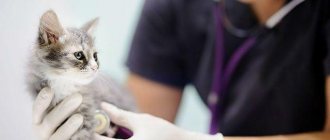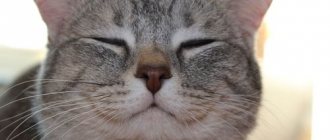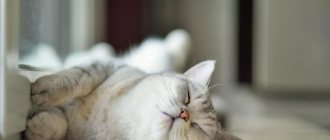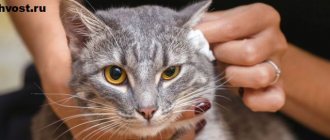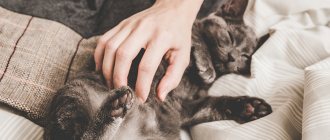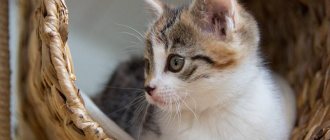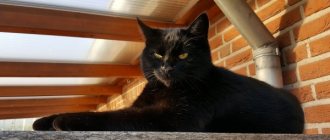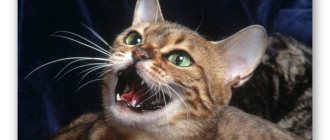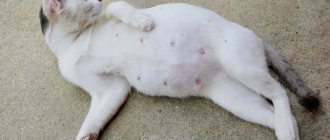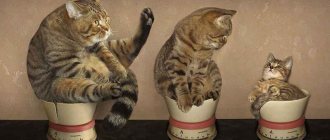Determining the cause of the disease in pets is more difficult than in people, because pets cannot talk about the nature of their illness or indicate symptoms. The owner of a four-legged friend must be attentive to his ward and try to promptly notice changes in behavior and health. If the owner notices whistling breathing in a cat, then this is a clear sign of blockage at some point between the bronchioles and the larynx. During negative processes, a narrowing of the airways is observed, therefore, when inhaling and exhaling, a characteristic whistling sound is produced.
Varieties
| Type | Peculiarities |
| Fine bubbles | The pathological sound is a consequence of the collapse of small air balls that are formed during sputum |
| Such wheezing is heard when the pet is sleeping or awake, and is characteristic of bronchitis, pneumonia and pulmonary infarction. | |
| Medium bubble | Reminds me of the sound of air blown through a tube |
| Observed with inflammation of the bronchi, which is associated with abundant accumulation of mucus | |
| Large-vesicular | Can be listened to without special devices |
| The cat exhibits noisy breathing with severe wheezing, and the pet can often burp liquid accumulated in the lungs | |
| Caused by pulmonary edema |
Veterinarians note that the cat may experience wheezing, whistling, dry or wet. At the same time, different types of noise are associated with different reasons and require special treatment.
The reason why a cat snores loudly when breathing
The respiratory system of cats is similar in structure to that of humans. They, just like humans, can sigh, grunt and even snore. If a cat sniffles not only in his sleep, this may be a symptom of an illness.
The animal begins to sniffle as a result of inflammation of the nasopharyngeal mucosa. This happens due to hypothermia or a cold.
The respiratory system of cats is similar to humans
A pet's runny nose often occurs as a result of exposure to chemicals. Rhinitis can be a consequence of any past illness.
If a cat sniffles, you need to monitor it; the sick pet constantly rubs its nose with its paws, often sneezes, and has difficulty breathing.
In addition, the pet looks apathetic, there is exhaustion, and the development of conjunctivitis.
In case of a cold or rhinitis, treatment must be carried out to avoid negative consequences.
The main causes of whistling breathing
Wheezing in a cat may indicate the following diseases:
- Heart disease. If the breeder notices changes in the behavior and well-being of the pet, then you should pay attention to the characteristic color of the lips, tongue and gums. If a gray or even blue tint of the oral cavity is detected, we can conclude that the cardiovascular system is not coping with its work and the tissues are not receiving oxygen. In this situation, you should look for the cause in the malfunction of the main organ - the heart. The veterinarian must do a cardiogram, an x-ray examination, and take blood and urine tests. After receiving the data, establishes an accurate diagnosis and prescribes adequate treatment;
- Helminthiasis. If your cat wheezes and coughs, the cause may be the presence of parasites - lungworms that live in the cavity of the respiratory organ. In this case, it is very important to assess the scale of the problem. As a rule, helminths are amenable to systemic treatment. Doctors recommend antihelminthic drugs;
- Asthma. A disease in which the animal develops severe shortness of breath, while whistling and hoarse meowing are heard. At this moment, the pet experiences a severe lack of oxygen and begins to actively breathe. Swelling of the lung tissue is very dangerous, as it can cause death. During an asthma attack, it is very important to promptly give the animal special medications that can instantly relieve swelling and allow normal breathing. Treatment in this case is prescribed systematically, with regular visits to the veterinarian for examination;
- Heart disease. Wheezing in a cat can be a characteristic sign of a heart muscle defect. To establish a diagnosis, it is necessary to undergo a hardware examination in the clinic. At the initial stage of development of the pathology, the doctor prescribes maintenance therapy for stable heart function. In severe cases, surgery may be prescribed;
- Oncological disease. Growing tumors and tissue tumors can cause breathing problems. Whistles appear as a result of blockage of the airways. Special treatment is required, including opioid drugs that reduce pain. If the doctor determines that it is possible to remove the tumor, surgery will be scheduled.
The respiratory process directly depends on the physical and mental state of the cat. When you feel normal, breathing should be even, calm, and silent. When feeling unwell, the pet begins to actively and quickly inhale air, while wheezing and whistling are heard.
Why is there a problem?
Cough is one of the main symptoms of rhinotracheitis in an animal.
If the kitten does not meow and its respiratory rhythm has changed, then in most cases the problem is associated with pathologies of the respiratory system. Many pulmonary diseases are characterized by copious secretion of saliva and mucus, which the pet often swallows. If a cat is breathing heavily and wheezing constantly, then this indicates a number of pathologies presented in the table.
| Disease | Short description | Additional symptoms |
| Rhinotracheitis and calcivirosis | The mucous membranes of the respiratory tract and intestines become inflamed | Heat |
| Diarrhea | ||
| Cough and severe wheezing | ||
| Ulcers on the mucous membranes | ||
| Purulent and mucous discharge from the eyes and nose | ||
| Pneumonia | Inflammatory reaction in the lungs associated with viruses and bacteria | Barking type cough |
| Temperature increase | ||
| Deterioration of general condition | ||
| Bronchial asthma | Chronic inflammation of the airways with narrowing of the pulmonary lumen | Frequently pressing the cat to the floor |
| The animal is breathing hoarsely and coughing | ||
| In advanced cases, the pet suffocates | ||
| Helminthiasis | Associated with the entry of small parasites into the respiratory tract | Vomiting and nausea |
| Breathing with wheezing | ||
| Broken stool | ||
| The pet eats almost nothing | ||
| Cancerous tumors | Accompanied by the proliferation of malignant cells in the respiratory organs | The cat grunts and sniffles when it breathes |
| Changed voice, and sometimes meowing disappears completely | ||
| Shortness of breath and cough with bloody impurities | ||
| Laryngeal edema or laryngospasm | Occurs against the background of poisoning with household chemicals, an allergic or autoimmune reaction | Acute lack of oxygen |
| Restless state | ||
| The cat meows hoarsely and moans often |
The animal may experience difficulty breathing due to the triplication of the skull.
- foreign body entering the throat;
- brachycephalic syndrome;
- pulmonary edema;
- congenital anomalies;
- tracheal collapse.
When a cat has hoarse breathing accompanied by a loud sound, this does not always signal a pathology in the respiratory system. Often a cat grunts and breathes through his mouth due to the following disorders:
- Protrusion of the diaphragmatic hernia. The symptoms are reminiscent of bronchial asthma, with the pet constantly being in one position and breathing heavily.
- Heart diseases. In case of heart failure, the animal rarely develops a cough, and the cat often wheezes and breathes through his mouth. Arrhythmia, myocardosis and myocarditis can affect impaired breathing.
- Severe renal failure. The pathology often provokes pulmonary edema, as a result of which the pet refuses to eat, is constantly in a semi-sitting position and coughs.
How to treat difficulty breathing with wheezing in a cat
Breathing with wheezing in a cat is treated in various ways and means. It all depends on the underlying disease, which the doctor determines and prescribes treatment.
- For swelling of the larynx, drugs that relieve swelling are used
- Bronchitis requires expectorants and cough medicines
- Chemotherapy is used to eliminate tumors and neoplasms
- Most foreign bodies can be removed using endoscopy
- Pulmonary edema will require intensive care, often requiring artificial ventilation
- Brachiocephalic syndrome and paralysis will require surgery
Regardless of the cause of wheezing, treatment results will be positive if you visit the clinic in a timely manner. Call us at Belaya Medveditsa around the clock, we will be happy to help.
Sign up for wheezing treatment
POLAR BEAR
The veterinary clinic in Nizhny Novgorod "White Bear" provides all types of services for cats and dogs.
Conducts any examinations and tests in its own veterinary laboratory; the clinic operates a veterinary ambulance for animals and a 24-hour veterinarian is on call at home. Agreement on the processing of personal data
Public offer
SITE MENU
- About the clinic
- Price list for veterinary clinic services
- Treatment
- Services
- Price list for veterinary clinic services
- Vetapteka
- Contacts
- Site Map
CONTACTS
- Nizhny Novgorod st. Vyatskaya 7
- 8 (831) 437-25-27
- [email protected]
Normal cat condition
If your feline pet sniffles, but does not express any pain, his behavior has not changed, he plays, eats well, you need to examine the animal:
- if the nasal mucosa is pink, then the body receives enough oxygen;
- there is no discharge from the nose, which means a cold is excluded;
- Light pressure over the entire back will help determine whether there are or are no areas of pain.
Breathing with wheezing may be caused by a deviated nasal septum or obesity, which is not life-threatening.
When your cat sniffles, she also scratches her nose with her paws and sneezes; perhaps she just has an allergy, which will disappear after the allergen is eliminated.
We invite you to familiarize yourself with the TOP 17 reasons why a cat constantly meows
Periodic snoring is normal for humans and animals.
When fast breathing is normal
Rapid breathing in cats (tachypnea, inspiratory dyspnea) is characterized by an increased number of inhalations and exhalations relative to the norm. It occurs in animals for a variety of reasons.
Important! Tachypnea can be physiological or pathological. Physiological rapid breathing is a natural process of cooling the body and is necessary for faster recovery.
When this condition develops, the pet most often stretches out its front legs and arches its back. However, tachypnea does not always signal the development of any pathological condition or process in the body.
Rapid breathing may be normal:
- in the first hours after the birth of kittens;
- with a long stay in a stuffy room, in the heat (overheating);
- if the cat is very thirsty;
- after intense physical activity, active games;
- during or immediately after eating;
- in stressful situations, after a strong emotional shock (transportation, change in familiar environment).
Rapid breathing in a cat can be caused by taking certain medications. In particular, when recovering from deep anesthesia.
A cat may pant frequently during pregnancy due to hormonal changes in the body during the rut.
As a rule, all of the above factors do not represent. The respiratory function will return to normal after some time, for example, after the normalization of the emotional state, the end of games, etc.
We also note that in representatives of brachycephalic breeds, due to the specific anatomical structure of the nasal passages (flattened nose), rapid breathing, especially in the hot season, is a physiological norm.
What to do and how to treat?
If the animal refuses to drink, you need to use a syringe without a needle to inject water.
- Provide the cat with constant access to drinking water. If the animal refuses, then try to inject the liquid with a syringe.
- Constant air humidification and ventilation in the place where the sick pet lives.
- Taking medications that provide symptomatic treatment.
Veterinarians warn that if a cat has a hoarse voice due to respiratory failure or asthma, then forceful watering is strictly prohibited. In this case, excess fluid is removed from the lungs, and in severe cases, surgery is performed.
Medications should be given to a sick animal for wheezing only on the recommendation of a veterinarian, since many of them have contraindications and can cause complications. If wheezing is associated with diseases of an infectious nature, then therapy must be supplemented with antibiotics. If the symptoms are accompanied by foamy nasal discharge with bloody impurities, then emergency hospitalization of the animal is required, since the risk of death is high.
Possible diseases and pathologies
When your pet snores constantly, or very often, it may be a symptom of one of the following conditions:
- swelling of the larynx; may be caused by allergies, or the presence of foreign objects in the respiratory system;
- urolithiasis disease; snoring is sometimes accompanied by wheezing;
- the presence of worms, which may even be present in the respiratory system;
- asthma;
- rhinitis;
- pneumonia and bronchitis;
- heart failure; along with wheezing, a cough and blue discoloration of the mucous membranes can be observed;
- respiratory tract infections;
- obesity.
A veterinarian will help the owner determine the cause of wheezing when breathing in a cat.
Treatment and prevention
The owner of the animal should not provide first aid to the pet, but quickly take it to the clinic. Only a veterinarian knows how to treat a disease that causes a cat to wheeze when breathing. The doctor prescribes conservative or surgical treatment.
Respiratory diseases can be prevented by following these rules:
- do not throw small objects on the floor;
- do not treat your pet to food with small bones;
- Vaccinate and deworm the animal in a timely manner.
Most diseases do not occur when the owner protects the cat from stress and provides adequate nutrition.
Diagnosis and treatment
Periodic snoring is normal for humans and animals. If this happens rarely, it should not be a cause for concern. But if it's a cat sniffling while breathing all the time, or even breathing with its mouth open, it should be a cause for concern. Persistent breathing problems can lead to more serious health problems.
Most likely, you will need a veterinarian's consultation and treatment, because... It is difficult or even impossible to independently determine the disease. But before contacting a doctor, it is necessary to observe an animal that is sniffling and breathing heavily. To make a diagnosis, exclude various diseases and prescribe the correct treatment, the doctor will need detailed information.
The veterinarian may ask for the following information about a cat who wheezes when he breathes:
- the age of the animal and its lifestyle;
- weight and its relationship with the norm for a given breed;
- how long ago did the wheezing occur?
- Are there other sounds heard when the cat breathes?
- changes in the color of mucous membranes;
- the presence of various injuries (torso, nose, mouth, larynx);
- changes in behavior (low activity, weakness, excitability);
- other symptoms (digestive problems, vomiting, other breathing problems, cough, runny nose, sneezing).
If your cat is breathing poorly through his nose and sniffling, you should not wait for this to go away on its own. Such signs may indicate a serious illness in a cat or kitten that requires immediate treatment.
Breathing problems in cats
Content
- Symptoms
- Causes
- Diagnostics
- Treatment
The respiratory system is made up of many parts, including the nose, throat (pharynx and larynx), airways, and lungs.
Air enters through the nose and is then transferred to the lungs through a process called inhalation. In the lungs, oxygen passes from the alveolar air into the blood. Red blood cells, in turn, carry oxygen to other organs of the body. It's all part of the physiological process of a healthy body. While oxygen is transferred to the red blood cells, carbon dioxide is transferred from the red blood cells to the lungs and exits through the airways on exhalation. This cyclical movement of breathing is controlled by the respiratory center of the brain and nerves in the chest. Diseases that affect the respiratory system or the respiratory center in the brain can cause breathing difficulties in cats. Problematic or difficult breathing is called shortness of breath, and excessively rapid breathing is called tachypnea (polypnea).
Respiratory problems can affect cats of any breed or age, and the condition can quickly become life-threatening. If your pet is having breathing problems, you should call your veterinarian at home as soon as possible or visit the clinic for an examination by a veterinary specialist. SYMPTOMS AND TYPES
Difficulty breathing (shortness of breath)
- The abdomen and chest move when breathing
- Dilated nostrils when breathing
- Breathing with your mouth open
- Unnatural posture (paws spread wide apart)
- The neck and head are kept low, in front of the body (extended)
- Problem may occur if inhaled
- Problem may occur when exhaling
- Noisy breathing (stridor)
Rapid breathing (tachypnea)
- Respiratory rate higher than normal
- Mouth is usually closed
Choking
- Rapid breathing
- Usually shallow breaths
- Open mouth
Other symptoms, depending on the cause of the breathing problem
- Cough
CAUSES
Dyspnea
Diseases of the nose
- Small (narrow) nostrils
- Infection with bacteria or viruses
- Tumors
- Bleeding
Diseases of the throat and upper respiratory tract (trachea)
- Elongated soft palate
- Tumors
- Foreign object stuck in throat
Diseases of the lungs and lower respiratory tract
- Infection with bacteria or viruses (pneumonia)
- Heart failure with fluid in the lungs (pulmonary edema)
- Enlarged heart
- Heartworm infection
- Tumors
- Bleeding in the lungs
Diseases of the small airways in the lungs (bronchi and bronchioles)
- Infection with bacteria or viruses
- Tumors
- Allergy
- Asthma
Diseases in the chest area surrounding the lungs (pleural space)
- Fluid caused by heart failure
- Air (pneumothorax)
- Blood in the chest (hemothorax)
- Tumors in the breast
Conditions that make the abdomen enlarged or bloated
- Enlarged liver
- Stomach full of air (bloating)
- Fluid in the abdomen (ascites)
Tachypnea (rapid breathing)
- Low oxygen levels in the blood (hypoxemia)
- Low red blood cell count (anemia)
- Suffocation
- Fluid in the lungs due to heart failure (pulmonary edema)
- Fluid in the chest space surrounding the lungs (pleural effusion)
- Bleeding in the lungs
- Tumors
Hard breath
- Pain
- Medications
- High body temperature (fever)
DIAGNOSTICS
If your cat has trouble breathing, it can be life-threatening. It is important to have the animal examined by a veterinarian as soon as possible. You will need to provide details about your pet's medical condition, the onset of symptoms, and possible incidents that may have preceded the condition. During the examination, the veterinarian carefully observes how the cat is breathing, checks the lungs for noises, and evaluates the color of the gums, since the color of the gums can be used to diagnose whether oxygen is being effectively delivered to the organs (hypoxemia) and whether there is a low level of red blood cells (anemia). Your veterinarian may try to get your cat to cough by pressing on the windpipe (tracheal reflex).
Standard tests include a complete blood count, biochemical profile, and urinalysis, which can be taken at home by your veterinarian to reduce stress for your pet. These tests will then help your veterinarian determine if your cat has an infection or low red blood cell count and what the ratio of oxygen to carbon dioxide is in the blood. They will also show whether your pet's internal organs are working normally. This will help determine how severe your cat's breathing difficulty is and whether the problem is in the lungs or elsewhere in the chest. Other diagnostic tools that can be used are X-rays and ultrasound images of the chest, both to examine an enlarged heart that may lead to heart failure and to determine whether the lungs are normal. The internal structure of the abdominal cavity can also be examined using this method. If fluid has accumulated in the chest, lungs, or abdomen, some of the fluid will be removed for testing.
If your cat does have heart problems, an ECG (electrocardiogram) is a direct indication to measure the heart's rhythm and electrical activity, which determines the heart's ability to function normally. If the problem is in the nose or respiratory tract, then an endoscopic examination will help identify the problem. These include rhinoscopy, tracheoscopy, laryngoscopy and bronchoscopy, respectively. It is also very important to collect fluid and cells that can be taken for biopsy analysis. TREATMENT
Treatment will depend on the final diagnosis made by your veterinarian. Most breathing problems require hospitalization until the cat can no longer take in enough oxygen on its own. Your pet will be given oxygen therapy and intravenous fluid therapy. The medications prescribed will depend on the cause of the breathing problem. The animal's activity will be limited until the breathing problem is resolved. Crate resting may be an option if you have no other way to restrict your cat's movement, and protecting her from other pets or active children is an important part of the healing process.
If you notice any changes in your cat's breathing, try to call a doctor to your home as soon as possible for a consultation.
The article was prepared by Semenova O.L.,
veterinary therapist at MEDVET © 2021 SEC MEDVET
When to take your cat to the vet
If your cat sniffles frequently, or breathes with her mouth open, this should alert you and cause a visit to the veterinarian. Before you see a doctor, you need to observe the animal for a couple of days in order to correctly answer questions in the veterinary hospital to make the correct diagnosis. The veterinarian may be interested in the following information:
- how long ago did the snoring begin?
- are there any accompanying sounds along with wheezing during breathing;
- whether the pet was injured;
- whether the animal’s usual behavior has changed;
- was there a change in the color of the mucous membranes;
- other symptoms (vomiting, runny nose, cough).
Persistent breathing problems can cause more serious health problems.
By the nature of snoring and additional sounds, you can determine the source of the disease:
- wheezing, coughing and blue mucous membranes signal heart failure;
- wheezing and wheezing indicate the presence of urolithiasis;
- wet rales may indicate phlegm in the respiratory system;
- crackling indicates problems in the alveoli;
- dry wheezing indicates the presence of edema in the bronchi or larynx;
- sniffling plus whistling may indicate swelling in the airway area.
A correct diagnosis and timely initiation of treatment will ensure a speedy recovery for the cat. There is no need to rely on the advice of other cat owners or information on websites. Each case is individual, even if the symptoms are similar.
Why can a cat sniff and grunt when breathing?
Quite often, a cat's breathing is accompanied by wheezing. As a rule, physiological factors act as the causes of this phenomenon. Such snoring should not cause concern to the pet owner.
When an animal is breathing heavily, grunting, sniffling and whistling through its nose, you should immediately show it to a veterinarian. Ignoring these symptoms caused by pathological factors can lead to serious consequences, including the death of the cat.
We suggest you read: Is it possible to give lard to chickens?
The respiratory system of these animals is similar in structure to humans. They, just like people, can sigh, sniffle, grunt, and snore. In most cases, this occurs due to natural causes and should not be a cause for concern. Your pet's wheezing may appear against the background of:
- Excessive physical activity. In healthy individuals, the respiratory rate depends on the degree of load. A cat breathes most calmly during sleep.
- Nervous shock. Experiencing excitement, fear, rage and excitement, the cat begins to breathe noisily. Breathing may be accompanied by wheezing. This is a short-term condition. It goes away after the source of stress disappears.
- Bearing offspring, feeding young and sexual desire. In all these situations, the cat's breathing quickens.
- Overheating. An overheated pet inhales air not through its nose, but through its mouth. He does it hard, with a whistle. The cat instinctively tries to spread out his whole body on the floor in the coolest room, usually on the tiles in the bathroom.
Among the pathological reasons that a pet is breathing loudly are:
- Swelling of the larynx. This pathological phenomenon most often occurs against the background of an allergic reaction or foreign objects entering the respiratory system.
- Asthma. The symptoms of this disease are difficult to ignore. It is characterized by attacks of suffocation not only at night, but also during the daytime.
- Formation of stones in the organs of the urinary system. In the presence of stones, breathing is often accompanied by wheezing.
- Helminthic infestations. Worms can affect any organs, including the respiratory organs, leading to disruption of their functioning as a result of blockage.
- Inflammation of the lungs and bronchi.
- Inflammatory process in the mucous membranes of the nose.
- Respiratory diseases.
- Heart failure. In this state, the animal not only breathes poorly, but also coughs. Blueness of the mucous membranes is also noted.
- Obesity. Excess body weight leads to increased stress on all organs, including the heart muscle. The chain of pathological reactions gradually results in such phenomena as heavy breathing and snoring.
- Injuries to the chest, spine, ribs. If the animal sticks out its tongue, it is breathing shallowly, it is trying to inhale more air, as if it is suffocating, most likely, breathing is causing it pain.
Diagnostic methods
Treatment is prescribed only after identifying the underlying disease that led to the appearance of these symptoms. To determine the root cause, the veterinarian prescribes a series of diagnostic procedures for the four-legged patient.
To make a preliminary diagnosis and select diagnostic methods, the doctor resorts to the following methods:
- examination of the animal’s upper respiratory tract, mucous membranes, eyes;
- auscultation (listening) of the trachea, bronchi and lungs;
- analysis of data on the conditions of keeping and nutrition of a four-legged patient, information about previous diseases suffered by him, features of the onset of the present pathological process;
- comparison of the animal’s weight with the norm for a given breed and age.
After carrying out the initial diagnostic procedures, the veterinarian prescribes the following types of laboratory and instrumental studies to the four-legged patient:
- clinical, biochemical, virological and bacteriological blood analysis;
- stool examination;
- Ultrasound and electrocardiogram of the heart;
- rhinoscopy;
- bronchoscopy;
- X-ray of the chest organs.
You may also need to consult with specialists. If necessary, the animal is prescribed a dental, oncological and surgical examination. The listed diagnostic procedures are standard. Such procedures are prescribed depending on the clinical picture.
How to help your pet depending on the cause of sniffling and grunting?
After identifying the cause of these symptoms and making an accurate diagnosis, the veterinarian will develop a treatment plan. It requires an integrated approach. Therapy is aimed at improving the animal’s condition and relieving signs of the underlying disease. If a four-legged patient has a cough, antitussive drugs (Sinekod, Bronholitin) are used to eliminate it.
For dry cough, expectorant medications (ammonium chloride, Salbutamol) are indicated. When nasal congestion occurs, the nasal passages are washed with saline solution. To relieve inflammation, they resort to rinsing with chamomile decoction. When the listed remedies are powerless, it is recommended to instill any children's drops (Nazivin, Otrivin, Vibrocil).
The main treatment depends on the diagnosis:
- For helminthic infestations, a course of antihelminthic drugs (Milbemax, Stronghold) is indicated.
- When an allergy is diagnosed, its symptoms are relieved with antiallergic drugs (Suprastin, Tavegil). It is important to identify and eliminate the source of the allergic reaction, otherwise treatment will be useless, and attacks of this disease will appear again and again.
- For infectious diseases, antibiotics or antiviral agents are prescribed.
- Symptoms of heart failure are eliminated with the help of glycosides and potassium-containing medications.
- For injuries of the chest, spine, and ribs, immobilization, antibiotic therapy, and painkillers are indicated.
- For obesity, a diet is prescribed.
- Inflammatory diseases are treated with anti-inflammatory drugs and broad-spectrum antibiotics (Streptomycin, Erythromycin).
- When diagnosing asthma, glucocorticosteroids and bronchodilators are indicated.
Owners sometimes notice that their pet snores in his sleep, and when awake, his breathing seems labored, with hoarseness or wheezing. There are many reasons for this phenomenon, from the most harmless to the potentially fatal.
The structure of a cat's respiratory system is similar to that of a human. Between the nose and the lungs are the nasopharynx, bronchi and trachea. Breathing provides the entire body with oxygen and ventilation of the lungs from waste gases. If atypical sounds are observed during this process, it is necessary to show the animal to a veterinarian.
We invite you to familiarize yourself with Veracol for cats and kittens
Impaired respiratory functions can be caused by causes that are not directly related to diseases that have pulmonary pathogenesis (edema, fibrosis, pneumonia), but are no less dangerous for the pet’s life. Failure of gas exchange in the body can be caused by:
- brain and spinal cord injuries;
- an inflammatory process affecting the central nervous system;
- heart failure;
- foreign objects caught in the nasopharynx.
Associated symptoms of a serious illness will be changes in the animal’s behavior:
- passivity;
- loss of appetite;
- purulent or foamy discharge from the nose and mouth when breathing;
- pale blueness of the mucous membrane.
Contacting a veterinarian is mandatory and urgent.
Other reasons
When a kitten, cat or cat sniffles, but does not show signs of pain, behaves naturally, plays, and does not lose appetite, it is worth conducting an accessible examination of the animal:
- 1. If the pet’s mucous membrane has a healthy pinkish color, the body does not lack oxygen.
- 2. The absence of nasal discharge excludes colds.
- 3. Light pressure along the entire length of the back will help determine the presence (absence) of areas of pain.
Hoarse breathing can be caused by a deviated nasal septum or obesity, which is no more dangerous for a cat than for a person.
If your pet is wheezing, scratching, or sneezing, the disorder may be caused by an allergic reaction. This condition develops in pets due to:
- household chemicals;
- synthetic materials (flooring, wall decoration);
- stern;
- mineral toilet filler.
In this case, it is necessary to isolate the animal from the allergen. Antihistamines can be used, but should not be overused.
In addition to the well-known sneezing, cats sometimes begin to snort, wrinkling their noses, and rubbing their faces with their paws. Of course, such uncharacteristic behavior often worries owners: why does the cat sneeze and snort through its nose? Is this normal, or should I still see a doctor? Let's try to answer these questions.
If the cat rarely performs such actions and generally feels well, then most likely nothing needs to be done. Perhaps the cat simply inhaled the dust and successfully got rid of it on her own. But if the condition worsens and becomes painful for the animal, action must be taken.
We wrote about the technique of rinsing the nose in the article “What to do at home if your cat sneezes?” - This is the only thing that can be done before being examined by a veterinarian. The procedure will help get rid of foreign particles in the nose.
If the reason lies in deeper inflammatory processes, serious examination and treatment cannot be avoided, which is why it is so important to see a doctor.
What canned food tastes best for cats?
RESEARCH ATTENTION! You and your cat can take part in it! If you live in Moscow or the Moscow region and are ready to regularly observe how and how much your cat eats, and also remember to write it all down, you will receive FREE SET OF WET FOOD.
From time to time, cats can catch a cold and experience quite serious respiratory (breathing) problems. If you notice breathing problems in your pet, it is very important to promptly contact your veterinarian so that he can find out the exact cause of the airway congestion and prescribe appropriate treatment.
Causes
If your cat stops meowing, you cannot do without an examination by a veterinarian. This is too serious a symptom, which indicates the emergence of significant health problems.
The reasons for this condition are:
- viral or infectious disease, cold;
- advanced acute respiratory infections - as a complication, a cat may develop pneumonia, viral rhinotracheitis, tonsillitis, calcivirosis, bronchial asthma;
- a foreign body in the larynx - a chicken bone, a sliver, a spruce or pine needle can damage the larynx from the inside, injure the respiratory tract, gastrointestinal tract;
- heart failure - if the cat’s behavior has become less active, she is breathing frequently, wheezing appears, there is a high probability of developing cardiovascular pathology;
- blood diseases - such ailments develop due to a lack of iron in the cat’s diet;
- hernia in the diaphragm area;
- pulmonary edema;
- allergic reaction to food taste, smell, dust;
- traumatic injuries to the respiratory system - most often they appear after a cat falls from a height or a fight;
- ascites – excess fluid in the abdominal cavity;
- swelling of the larynx after poisoning with a chemical substance (for example, household products);
- oncology.
Important! Sometimes heart problems in cats develop asymptomatically. This continues until a certain point, while the body tries to even out the situation. As soon as the reserve forces run out, the condition deteriorates sharply. Characteristic, rapidly increasing symptoms of heart failure appear, and the cat may become hoarse.
Respiratory system diseases
If your cat becomes hoarse suddenly, tracheitis may be the cause. The disease often occurs:
- due to hypothermia;
- infection by viruses or bacteria;
- drying out of the trachea itself during sleep (this usually happens in the cold season when the batteries are working);
- exposure to fumes from chemicals (for example, varnishes or paints after repairs).
A cat with tracheitis is breathing heavily with its stomach. Due to a strong barking cough, sore throat and wheezing, he is constantly in severe pain. This condition of the pet requires immediate treatment. The cat needs to be taken to the veterinary clinic as quickly as possible.
Important! If you make an appointment by phone in advance, you won’t have to wait in the hallway with a sick animal.
Pneumonia in cats can be caused by viruses, fungi or bacteria. If not treated in time, the disease leads to pulmonary edema.
Signs of this pathology in cats are:
- Wheezing with gurgling.
- Phlegmatic state, lethargy, frequent sleep.
- While breathing, the cat inflates its abdomen and its tongue protrudes from its slightly open mouth. She coughs in an attempt to get rid of the fluid in her lungs.
- The mucous membrane in the mouth has a bluish tint.
- Discharge of mucus from the nose.
- Coughing up blood with sputum.
Important! Do not delay contacting an experienced specialist. Self-medication can harm the health of a weakened pet.
In asthma, the bronchi are affected and the airways are inflamed. The bronchi narrow due to the activation of the allergic mechanism, the infection is secondary.
Symptoms of asthma development:
- A wheeze appears and the cat presses itself to the floor.
- He cranes his neck and coughs.
- The appearance of shortness of breath.
- Increasing intensity of wheezing, almost to the point of suffocation.
It is still unknown what causes feline asthma. Doctors recommend preventing the animal from coming into contact with chemical fumes, smoke, and dust accumulations.
Pleurisy often results from various cardiomyalgia. It can also develop due to the accumulation of purulent masses inside the pleural cavity. This disrupts breathing, prevents the lungs from fully expanding, and provokes wheezing.
Sometimes infectious peritonitis leads to pleurisy. The mucous membranes of the cat's tongue turn blue and she can't stop coughing. Fluid accumulates between the chest and lungs. The cat is constantly wheezing and breathing frequently.
Important! If clinical signs of pleurisy appear, you must immediately show your pet to a veterinarian and begin treatment.
Other pathologies
If your pet has weak kidneys, the final outcome of the disease is pulmonary edema. A sick cat does not eat or drink. Most of the time he is in a semi-sitting position, his sides swelling and falling rhythmically. From time to time the cat begins to cough, and the wheezing intensifies.
Malignant or benign neoplasms on organs that are located near the respiratory tract can cause hoarseness in a cat. As a rule, this indicates metastases in the lungs. Experts note that cats suffer from cancer more often than dogs.
Heavy breathing through an open mouth, wheezing of any type, or discharge from the cat's mouth or nose are sufficient grounds for consultation with a medical professional. The doctor determines the causes of the cat’s condition using tests (ultrasound, x-rays, biopsy), external examination, and history taking.
The cause of a cat's hoarse meowing is often polyps in the nasopharynx, hair inside the intestines, or small objects stuck in the throat. But most often the cat wheezes and breathes heavily with his mouth open due to the development of pulmonary or extrapulmonary pathology. Among the latter, heart disease comes first.
Statistically, overweight or older cats have an increased risk of developing heart failure. Wheezing is often a sign.
The fact that a cat is hoarse due to heart problems is indicated by:
- Severe shortness of breath after minor physical exertion.
- Cold pads on paws and ears.
- Pallor of mucous membranes (gums, palate, eyes) due to poor circulation.
- Sounds that resemble bubbling, with a background of wheezing.
- Cold skin.
After the examination, the doctor prescribes an x-ray, electrocardiography, and develops an individual treatment plan, which includes the use of dietary food.
Interesting! It happens that a cat wheezes due to a helminthic infestation. Small parasites penetrate the respiratory tract, cause nausea, and provoke a refusal to eat. As a rule, with helminthiasis, a kitten wheezes when breathing, and stool disturbances are noted.
Preventive actions
To prevent the listed diseases, one of the symptoms of which is sniffling and grunting in a pet, the following safety measures must be observed:
- Carry out vaccinations and deworming in a timely manner. Such measures will help avoid the development of infectious diseases and the appearance of parasites.
- If your pet has an allergy, eliminate its sources in the apartment and avoid the cat’s contact with allergens outside the home.
- Avoid overeating. Do not leave uneaten food in the bowl. If you gain excess weight, it is recommended to switch your pet to a low-calorie diet. Sterilized cats and neutered cats must be fed special food.
- Avoid hypothermia and overheating of the pet and drafts.
- Increase the animal’s immunity through the regular use of vitamin and mineral complexes, agreed with the veterinarian.
- Conduct regular preventive veterinary examinations to promptly identify existing diseases.
- Start eliminating signs of pathologies immediately after they are identified.
